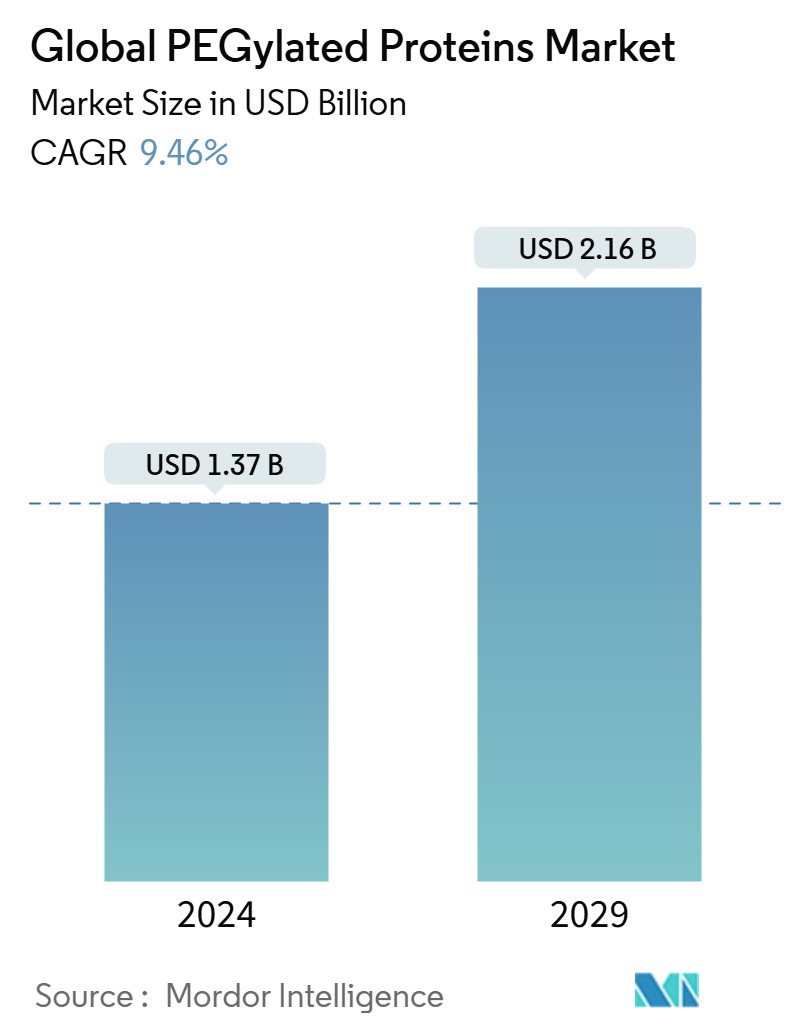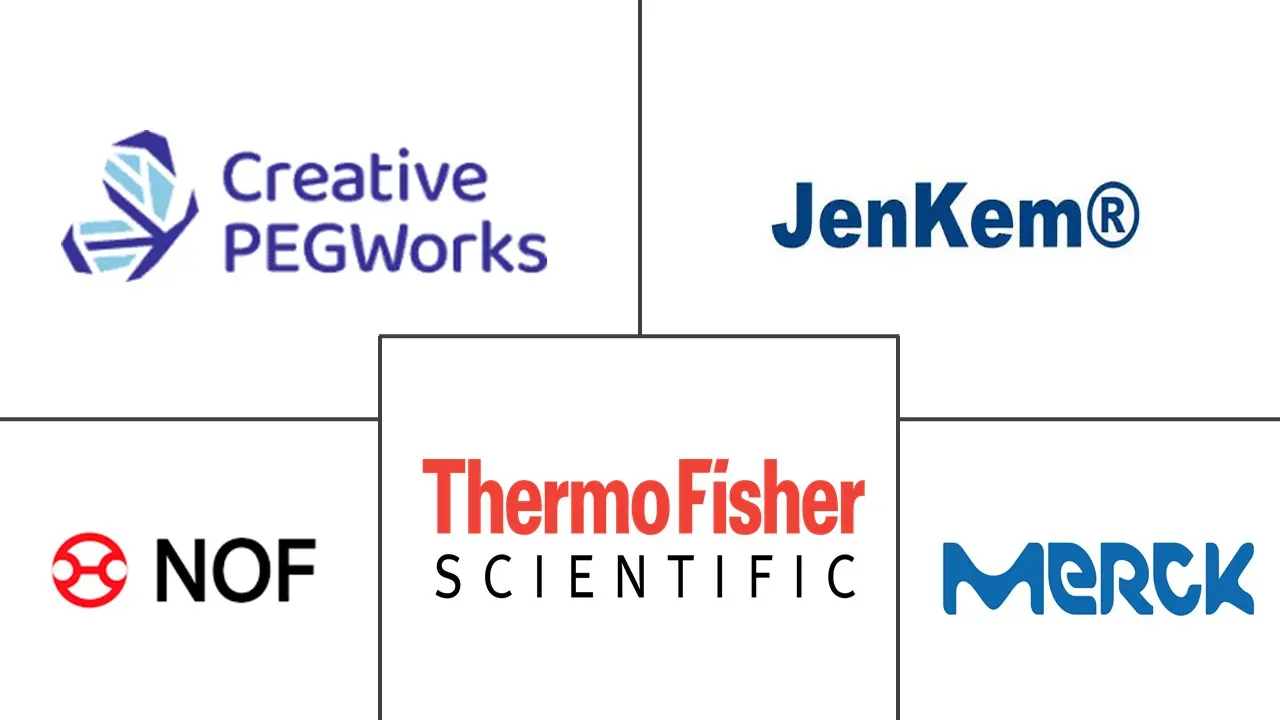Market Size of Global PEGylated Proteins Industry

| Study Period | 2019 - 2029 |
| Market Size (2024) | USD 1.37 Billion |
| Market Size (2029) | USD 2.16 Billion |
| CAGR (2024 - 2029) | 9.46 % |
| Fastest Growing Market | Asia-Pacific |
| Largest Market | North America |
| Market Concentration | Medium |
Major Players
*Disclaimer: Major Players sorted in no particular order |
PEGylated Proteins Market Analysis
The Global PEGylated Proteins Market size is estimated at USD 1.37 billion in 2024, and is expected to reach USD 2.16 billion by 2029, at a CAGR of 9.46% during the forecast period (2024-2029).
The impact of COVID-19 on the PEGylated proteins market was moderate. According to the study published in Biomaterial in June 2021, PEGylated nanoparticle albumin-bound (PNAB) -steroidal ginsenoside can effectively lower histone H4 and NETosis-related factors in the plasma and ameliorate SREBP2-mediated systemic inflammation in SARS-CoV-2 ICU patients. PNAB-steroidal ginsenoside medications may be useful in treating symptoms associated with severe SARS-CoV-2 patients, such as coagulation and cytokine storm. Furthermore, according to an article published by PubMed Central in August 2021, a phase III clinical trial showed the efficacy and safety of pegylated interferon alpha-2b (PEG IFN-α2b) in patients with moderate COVID-19 infections. Thus, given the extensive research activities based on PEGylation technology, the COVID-19 pandemic impacted the market moderately; however, as the pandemic has subsided currently, the studied market is expected to have stable growth during the forecast period of the study.
The major factor attributing to the growth of the market is the increasing prevalence of chronic diseases like cancer, kidney diseases, and rheumatoid arthritis. According to the data from the American Cancer Society 2022, an estimated 1,908,030 new cancer cases are expected to be diagnosed in the United States in 2022. Moreover, as per the same source, among all cancers, digestive system cancer is expected to account for 343,040 cases, breast cancer is expected to account for 290,560 new cancer cases, followed by respiratory system cancer, with 254,850 new cases in 2022. Additionally, as per the Global HIV and AIDS Statistics, 2022 fact sheet by UNAIDS, 38.4 million people globally were living with HIV in 2021. Thus, with the growing burden of chronic and infectious diseases such as cancer, HIV, tuberculosis, and others globally, the demand for developing medicine is also expected to increase, which will boost the research on protein, thus driving the PEGylated protein market.
Furthermore, biotechnology and pharmaceutical companies' growing investments in research and development programs are boosting the market growth. For instance, in March 2022, Flow Eighteen38, a protein sciences division created to facilitate and accelerate antibody characterization and protein purification projects, announced a EUR 5 million (USD 5.58 million) investment into its protein production and biophysical characterization capabilities and services from its parent company, CRO FairJourneyBiologics S.A. In addition, there is rising adoption of protein-based drugs over non-protein-based drugs wherein PEGylation increases the circulation and half-life of the proteins, improving the efficacy.
Therefore, the factors above, such as the growing burden of chronic and infectious diseases such as cancer, HIV, tuberculosis, and others globally, and the growing investments in research and development programs by biotechnology and pharmaceutical companies, the market is expected to experience growth. However, the high drug failure rates and drug recalls are the major factors impeding the market's growth.
PEGylated Proteins Industry Segmentation
As per the scope of the report, PEGylation is the process of binding or alteration of biological molecules by conjugation with polyethylene glycol is known as PEGylation. PEGylation enhances the stability and solubility of the drug and declines immunogenicity by changing the molecule's electrostatic binding, confirmation, and hydrophobicity. The PEGylated Proteins Market is Segmented by Product Type (PEGylation Kits and Reagents (Monofunctional Linear PEGs, Bifunctional PEGs), Services, and Other Product Types), Protein Type (Colony-stimulating Factor, Interferon, Erythropoietin, and Other Protein Types), End User (Pharmaceutical and Biotechnology Companies, Contract Research Organizations, and Academic Research Institutes), and Geography (North America, Europe, Asia-Pacific, Middle East and Africa, and South America). The market report also covers the estimated sizes and trends for 17 countries across major regions globally. The report offers the value (USD) for the above segments.
| By Product Type | ||||
| ||||
| Services | ||||
| Other Product Types |
| By Protein Type | |
| Colony-stimulating Factors | |
| Interferons | |
| Erythropoietin | |
| Other Protein Types |
| By End User | |
| Pharmaceutical and Biotechnology Companies | |
| Contract Research Organizations | |
| Academic Research Institutes |
| Geography | ||||||||
| ||||||||
| ||||||||
| ||||||||
| ||||||||
|
Global PEGylated Proteins Market Size Summary
The PEGylated proteins market is poised for significant growth, driven by the increasing prevalence of chronic and infectious diseases such as cancer, HIV, and tuberculosis. This demand is further bolstered by the rising investments in research and development by biotechnology and pharmaceutical companies, which are focusing on developing protein-based drugs that leverage PEGylation technology to enhance efficacy and longevity in the bloodstream. The market's expansion is also supported by the moderate impact of the COVID-19 pandemic, which spurred research into PEGylated therapies, although the market is expected to stabilize as the pandemic's effects wane. Despite challenges such as high drug failure rates and recalls, the market continues to benefit from advancements in protein sciences and the growing adoption of alternative therapeutics.
North America is anticipated to maintain a significant share of the PEGylated proteins market, attributed to its robust healthcare infrastructure, high prevalence of chronic diseases, and increased awareness of advanced treatment options. The region's growth is further supported by beneficial government initiatives and research partnerships, which are expected to drive innovation and development in the field. The market is moderately consolidated, with key players like Merck KGaA and Thermo Fisher Scientific Inc. leading through strategic acquisitions, partnerships, and new product launches. These companies are actively enhancing their capabilities in PEGylated products, as evidenced by recent developments such as the approval of novel therapies and the acquisition of specialized biopharmaceutical firms.
Global PEGylated Proteins Market Size - Table of Contents
-
1. MARKET DYNAMICS
-
1.1 Market Overview
-
1.2 Market Drivers
-
1.2.1 High Prevalence of Chronic Diseases
-
1.2.2 Increasing Adoption of Protein Treatments
-
1.2.3 Rise in Research and Development Funding by Key Players
-
-
1.3 Market Restraints
-
1.3.1 Drug Failures and Drug Recalls
-
-
1.4 Porter's Five Forces Analysis
-
1.4.1 Threat of New Entrants
-
1.4.2 Bargaining Power of Buyers/Consumers
-
1.4.3 Bargaining Power of Suppliers
-
1.4.4 Threat of Substitute Products
-
1.4.5 Intensity of Competitive Rivalry
-
-
-
2. MARKET SEGMENTATION (Market Size by Value)
-
2.1 By Product Type
-
2.1.1 PEGylation Kits and Reagents
-
2.1.1.1 Monofunctional Linear PEGs
-
2.1.1.2 Bifunctional PEGs
-
-
2.1.2 Services
-
2.1.3 Other Product Types
-
-
2.2 By Protein Type
-
2.2.1 Colony-stimulating Factors
-
2.2.2 Interferons
-
2.2.3 Erythropoietin
-
2.2.4 Other Protein Types
-
-
2.3 By End User
-
2.3.1 Pharmaceutical and Biotechnology Companies
-
2.3.2 Contract Research Organizations
-
2.3.3 Academic Research Institutes
-
-
2.4 Geography
-
2.4.1 North America
-
2.4.1.1 United States
-
2.4.1.2 Canada
-
2.4.1.3 Mexico
-
-
2.4.2 Europe
-
2.4.2.1 Germany
-
2.4.2.2 United Kingdom
-
2.4.2.3 France
-
2.4.2.4 Italy
-
2.4.2.5 Spain
-
2.4.2.6 Rest of Europe
-
-
2.4.3 Asia-Pacific
-
2.4.3.1 China
-
2.4.3.2 Japan
-
2.4.3.3 India
-
2.4.3.4 Australia
-
2.4.3.5 South Korea
-
2.4.3.6 Rest of Asia-Pacific
-
-
2.4.4 Middle East and Africa
-
2.4.4.1 GCC
-
2.4.4.2 South Africa
-
2.4.4.3 Rest of Middle East and Africa
-
-
2.4.5 South America
-
2.4.5.1 Brazil
-
2.4.5.2 Argentina
-
2.4.5.3 Rest of South America
-
-
-
Global PEGylated Proteins Market Size FAQs
How big is the Global PEGylated Proteins Market?
The Global PEGylated Proteins Market size is expected to reach USD 1.37 billion in 2024 and grow at a CAGR of 9.46% to reach USD 2.16 billion by 2029.
What is the current Global PEGylated Proteins Market size?
In 2024, the Global PEGylated Proteins Market size is expected to reach USD 1.37 billion.

